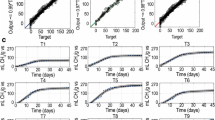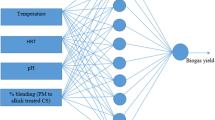Abstract
As one of the sources of renewable energies, ethanol is produced from lignocellulosic compounds and food waste during the fermentation process. In the present study, the capability of electronic nose (e-nose) system and machine learning approaches was evaluated of classification/prediction of bioethanol production and sensor responses as real-time monitoring. For this purpose, rice and wheat residual were conducted by acid-ultrasound, thermal-acid hydrolysis, and plasma technology, respectively. Then, the prepared substance was poured into both a pneumatic anaerobic digester (PAD) and a mechanical anaerobic digester (MAD). The fermentation process lasted for 20 days and data were acquired every five days. The output of each reactor was examined after the distillation stage. For this purpose, the output bioethanol was injected into an e-nose with an arrangement of 13 sensors, and the feature of the produced bioethanol was investigated by gas sensors. The response of the sensors was predicted and identified by chemometric methods. Moreover, the optimal responses with time and type of digester were investigated by RSM (Response Surface Methodology). The obtained results indicated that given the significance coefficient, the gas sensors MQ135, MQ2, MQ7, MQ9, TGS2620, and TGS822 had the highest rate of detection. Moreover, the obtained results showed that the PAD generated different gas compounds within the produced bioethanol when compared with the MAD. In addition, all chemometric methods had high accuracy for classification and prediction.






Similar content being viewed by others
References
Casabar JT, Ramaraj R, Tipnee S, Unpaprom Y (2020) Enhancement of hydrolysis with Trichoderma harzianum for bioethanol production of sonicated pineapple fruit peel. Fuel 279:118437
Gavahian M, Munekata PE, Eş I, Lorenzo JM, Khaneghah AM, Barba FJ (2019) Emerging techniques in bioethanol production: from distillation to waste valorization. Green Chem 21(6):1171–1185
Carrillo-Nieves D, Alanís MJR, de la Cruz Quiroz R, Ruiz HA, Iqbal HM, Parra-Saldívar R (2019) Current status and future trends of bioethanol production from agro-industrial wastes in Mexico. Renew Sustain Energy Rev 102:63–74
Kumar P, Kumar V, Kumar S, Singh J, Kumar P (2020) Bioethanol production from sesame (Sesamum indicum L.) plant residue by combined physical, microbial and chemical pretreatments. Bioresour Technol 297:122484
Darwesh OM, El-Maraghy SH, Abdel-Rahman HM, Zaghloul RA (2020) Improvement of paper wastes conversion to bioethanol using novel cellulose degrading fungal isolate. Fuel 262:116518
Yu KL, Chen WH, Sheen HK, Chang JS, Lin CS, Ong HC, Ling TC (2020) Production of microalgal biochar and reducing sugar using wet torrefaction with microwave-assisted heating and acid hydrolysis pretreatment. Renew Energy. https://doi.org/10.1016/j.renene.2020.04.064
Darwesh OM, El-Latief A, Aya H, Abuarab ME, Kasem MA (2021) Enhancing the efficiency of some agricultural wastes as low-cost absorbents to remove textile dyes from their contaminated solutions. Biomass Convers Biorefinery 13:1241–1250
Lennartsson PR, Erlandsson P, Taherzadeh M, Gundberg A (2018) U.S. Patent No. 9,994,872. Washington, DC: U.S. Patent and Trademark Office.
Alvira P, Tomás-Pejó E, Ballesteros M, Negro MJ (2010) Pretreatment technologies for an efficient bioethanol production process based on enzymatic hydrolysis: a review. Biores Technol 101(13):4851–4861
Balat M, Balat M (2009) Political, economic and environmental impacts of biomass-based hydrogen. Int J Hydrog Energy 34(9):3589–3603
MacLellan J (2012) Anaerobic Treatment of Lignocellulosic Material for Energy Generation. Michigan State University. Biosystems Engineering
Yat SC, Berger A, Shonnard DR (2008) Kinetic characterization for dilute sulfuric acid hydrolysis of timber varieties and switchgrass. Biores Technol 99(9):3855–3863
Mohammad-Razdari A, Rousseau D, Bakhshipour A, Taylor S, Poveda J, Kiani H (2022) Recent advances in E-monitoring of plant diseases. Biosens Bioelectron 201:113953
Feng Y, Tian X, Chen Y, Wang Z, Xia J, Qian J, Chu J (2021) Real-time and on-line monitoring of ethanol fermentation process by viable cell sensor and electronic nose. Bioresour Bioprocess 8(1):1–10
Aguinaga Bósquez JP, Kovacs Z, Gillay Z, Bázár G, Palkó C, Hingyi H, Tóth T (2021) Evaluating the effect of a brewery by-product as feed supplementation on the quality of eggs by means of a human panel and E-tongue and E-nose analysis. Chemosensors 9(8):213
Men H, Shi Y, Jiao Y, Gong F, Liu J (2018) Electronic nose sensors data feature mining: a synergetic strategy for the classification of beer. Anal Methods 10:2016–2025
Lopez PC, Feldman H, Mauricio-Iglesias M, Junicke H, Huusom JK, Gernaey KV (2019) Benchmarking real-time monitoring strategies for ethanol production from lignocellulosic biomass. Biomass Bioenerg 127:105296
Marison I, Hennessy S, Foley R, Schuler M, Sivaprakasam S, Freeland B (2013) The choice of suitable online analytical techniques and data processing for monitoring of bioprocesses. Measurement, monitoring, modelling and control of bioprocesses 132:249–280
Marose S, Lindemann C, Ulber R, Scheper T (1999) Optical sensor systems for bioprocess monitoring. Trends Biotechnol 17(1):30–34
Mabood F, Hussain J, Jabeen F, Abbas G, Allaham BA, Albroumi M, Haq QM (2018) Applications of FT-NIRS combined with PLS multivariate methods for the detection & quantification of saccharin adulteration incommercial fruit juices. Food Addit Contam. https://doi.org/10.1080/19440049.2018.1457802
Shanmuganathan S, Samarasinghe S (eds) (2016) Artificial neural network modelling, vol 628. Springer, Switzerland
Wang B, Deng J, Jiang H, Chen Q (2022) Electronic nose signals-based deep learning models to realize high-precision monitoring of simultaneous saccharification and fermentation of cassava. Microchem J 182:107929
Siqueira AF, Vidigal IG, Melo MP, Giordani DS, Batista PS, Ferreira AL (2019) Assessing waste cooking oils for the production of quality biodiesel using an electronic nose and a stochastic model. Energy Fuels 33(4):3221–3226
Kasani AA, Esmaeili A, Golzary A (2022) Software tools for microalgae biorefineries: cultivation, separation, conversion process integration, modeling, and optimization. Algal Res 61:102597
Myers RH, Montgomery DC, Anderson-Cook CM (2016) Response surface methodology: process and product optimization using designed experiments. John Wiley & Sons
Niju S, Nishanthini T, Balajii M (2020) Alkaline hydrogen peroxide-pretreated sugarcane tops for bioethanol production—a process optimization study. Biomass Convers Bioref 10(1):149–165
Oh J, Kim SH, Lee MJ, Hwang H, Ku W, Lim J, Hwang JH (2022) Machine learning-based discrimination of indoor pollutants using an oxide gas sensor array: High endurance against ambient humidity and temperature. Sens Actuators B: Chem 364:131894
Shooshtari M, Salehi A (2022) An electronic nose based on carbon nanotube-titanium dioxide hybrid nanostructures for detection and discrimination of volatile organic compounds. Sens Actuators, B Chem 357:131418
Lasserre A, Grzelak L, Rossignol J, Brousse O, Stuerga D, Paindavoine M (2022) From microwave gas sensor conditioning to ammonia concentration prediction by machine learning. Sens Actuators, B Chem 367:132138
Khorramifar A, Karami H, Lvova L, Kolouri A, Łazuka E, Piłat-Rożek M, Darvishi Y (2023) Environmental engineering applications of electronic nose systems based on MOX gas sensors. Sensors 23(12):5716
Cevoli C, Cerretani L, Gori A, Caboni MF, Toschi TG, Fabbri A (2011) Classification of Pecorino cheeses using electronic nose combined with artificial neural network and comparison with GC–MS analysis of volatile compounds. Food Chem 129(3):1315–1319
Yoosefian SH, Ebrahimi R, Samani BH, Maleki A (2022) Modification of bioethanol production in an innovative pneumatic digester with non-thermal cold plasma detoxification. Biores Technol 350:126907
Bera S, Banerjee T, Samanta A (2021) Evaluation of enzymatic delignification of rice straw residues for bioethanol production. Int J Renew Energy Technol 12(2):99–117
Sahu O (2021) Appropriateness of rose (Rosa Hybrida) for bioethanol conversion with enzymatic hydrolysis: sustainable development on green fuel production. Energy 232:120922
Author information
Authors and Affiliations
Corresponding author
Additional information
Publisher's Note
Springer Nature remains neutral with regard to jurisdictional claims in published maps and institutional affiliations.
Rights and permissions
Springer Nature or its licensor (e.g. a society or other partner) holds exclusive rights to this article under a publishing agreement with the author(s) or other rightsholder(s); author self-archiving of the accepted manuscript version of this article is solely governed by the terms of such publishing agreement and applicable law.
About this article
Cite this article
Yoosefian, SH., Ebrahimi, R., Bakhshipour, A. et al. Real-time monitoring of agricultural waste conversion to bioethanol in a pneumatic system by optimized electronic nose. J Mater Cycles Waste Manag 26, 421–434 (2024). https://doi.org/10.1007/s10163-023-01847-w
Received:
Accepted:
Published:
Issue Date:
DOI: https://doi.org/10.1007/s10163-023-01847-w




